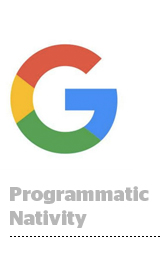 If someone asked you to rattle off the big buzzwords in media, it’s a pretty good bet mobile, native ads and programmatic would be somewhere near the top of your list.
If someone asked you to rattle off the big buzzwords in media, it’s a pretty good bet mobile, native ads and programmatic would be somewhere near the top of your list.
Google has just knocked down all three in a single gesture, allowing its publisher customers to expose native ad inventory in their mobile apps to buyers on the DoubleClick Ad Exchange.
The long-expected move is likely to bring a flood of new advertiser dollars to native ads, observers say, including from big brand advertisers that routinely scoop up IAB standard placements on exchanges, but whose “native programmatic” buys have been largely relegated to Facebook, Twitter and the small crop of ad tech vendors that have sprouted up in this space.
“Native has been a huge focus of ours for a while now, and there are several pieces that have to come together to make this work at scale programmatically,” said Jonathan Bellack, director of product management who oversees DoubleClick for Publishers and the DoubleClick Ad Exchange.
Native remains a relatively small percentage of overall digital media spend — $3.4 billion this year, according to eMarketer — but it’s growing rapidly. A survey from the Association of National Advertisers conducted in Q4 2014 found 63% of respondents planned to increase native ad budgets in 2015.
Initially, Google’s programmatic monetization is restricted to mobile app ads, where the company sees the greatest opportunity. Native web ads – both desktop and mobile — will follow early in 2016. The offering is available for both open exchange and private marketplace buys.
EBay trialled the Google programmatic native sales channel. Since introducing its new native ad unit, the commerce publisher said it saw a 3.6x increase in ad engagement on average, with some campaigns delivering click-through rates up to 5%.
“We’re focused on leveraging DoubleClick’s technical footprint to bring scalability to our native mobile programmatic offering,” said Brian Brownie, eBay’s director of U.S. display operations and programmatic advertising, in a statement.
Bellack said Google’s big engineering challenge in making publishers’ custom native formats available on exchanges was separating the assets of an advertiser’s creative from the ad spec as defined by the publisher.
To get there, Google introduced two standard native templates that any publisher wanting to sell programmatically can use: one for content-driven marketing and one for app install ads. The publisher can customize these templates according to the look and feel of their properties.
From an advertiser’s perspective, the process for buying native ads is substantially different from transacting on a banner ad. Rather than upload pre-defined ad creatives for delivery to familiar banner-sized boxes, a buyer instead provides a collection of ad assets: champion image, headline, body copy and so on. Google then assembles and serves the ad according to the publisher’s user experience.
“As an advertiser you need to think about assets that will work in a range of presentations,” Bellack said. “We had to build that tech that could have those two things [the publisher spec and the creative assets] be separated.”
Google is not the first to tackle this challenge. Other companies offering native programmatic ads include Facebook, Twitter, Yahoo and a group of ad tech specialists including Sharethrough, TripleLift and Bidtellect.
USA Today is among the publishers already leveraging DFP to serve native ads, a capability introduced earlier this year. In the absence of a Google programmatic sales channel, the company has partnered with Sharethrough to monetize that inventory.
Chris Pirrone, general manager at USA Today Sports Media Group, was briefed recently on Google’s new push into exchange-traded native ads.
“I think it’s impressive, what they’ve built,” Pirrone said. “Programmatic has always been about defining ad slots and therefore allowing everyone to transact on standard native formats and sizes. Native doesn’t work that way. I think initially it was outside Google’s comfort zone, and I’m impressed that they pushed it through. It lends credence to how important native is.”
From the buyer perspective, Google’s move is likely to bring a new type of advertiser into the programmatic native fray, according to Michael Collins, CEO of mobile DSP Adelphic.
“Given Google’s scale, it can help accelerate adoption of native inventory by brands,” he said. “The performance is great. Not just the click through rate, but the post-click engagement is very strong. That said, the adoption we’re seeing from brands as opposed to performance advertisers hasn’t really taken off yet.”
Separately, Google has introduced programmatic support for video in mobile interstitial placements in apps.
“It’s a format that consumers are comfortable with once they’re in the world of an interstitial in an app. As we know there’s a lot of demand,” Bellack said.














